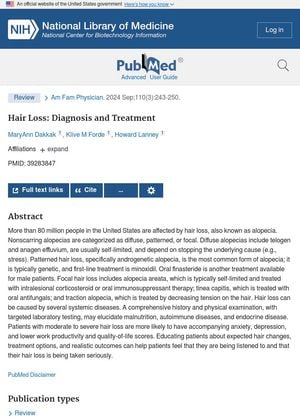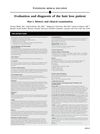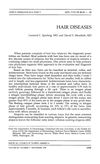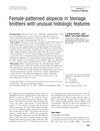Hair Loss: Diagnosis and Treatment
September 2024
in “
PubMed
”
diffuse alopecias patterned hair loss focal nonscarring alopecias telogen effluvium anagen effluvium androgenetic alopecia minoxidil oral finasteride alopecia areata corticosteroids immunosuppressants tinea capitis antifungals traction alopecia malnutrition autoimmune diseases endocrine diseases Rogaine Propecia

TLDR Hair loss can be treated based on its type and cause, improving quality of life.
More than 80 million people in the United States are affected by hair loss, or alopecia. Nonscarring alopecias are categorized as diffuse, patterned, or focal. Diffuse alopecias, such as telogen and anagen effluvium, are usually self-limited and depend on addressing the underlying cause. Patterned hair loss, particularly androgenetic alopecia, is the most common form and is typically genetic, with minoxidil as the first-line treatment and oral finasteride available for male patients. Focal hair loss includes alopecia areata, treated with intralesional corticosteroids or oral immunosuppressants; tinea capitis, treated with oral antifungals; and traction alopecia, treated by reducing hair tension. Hair loss can also result from systemic diseases, and a thorough history, physical examination, and targeted laboratory tests can identify causes like malnutrition, autoimmune diseases, and endocrine disorders. Patients with moderate to severe hair loss often experience anxiety, depression, and reduced quality of life. Educating patients about hair changes, treatment options, and realistic outcomes is crucial for their well-being.





